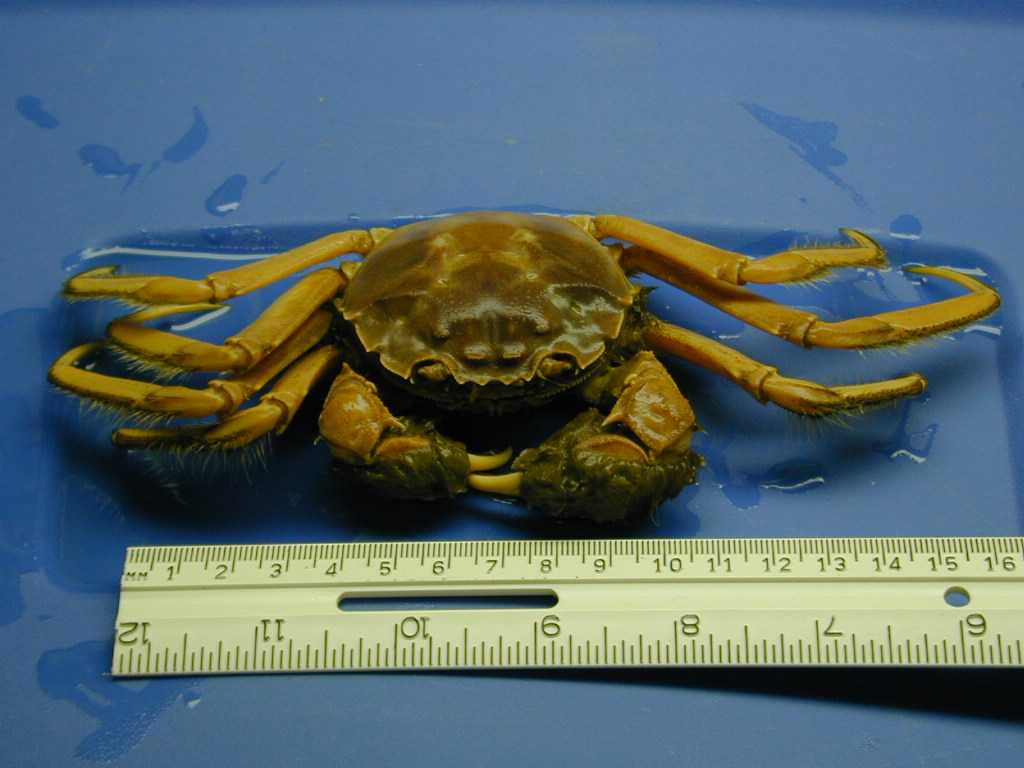
Posted on 02/08/2006 8:02:32 AM PST by Willie Green
An old fisherman told me about a new species of crab in the waters of New England. Wasn't too clear a story though. Like most old fishermen, he was bombed.

ping. It's the Crab People again!
First-ever Migratory Freshwater Crab in the St. Lawrence River
 |
|
| Chinese Mitten Crab (Eriocheir sinensis) |
A Surprising Discovery in the Water of the St. Lawrence River
While conducting sampling activities in the Quebec City area, Yves de Lafontaine, a research scientist at the St. Lawrence Centre, was approached by a fisherman about an unusual catch he’d made on September 2, 2004. The strange-looking crab was caught in an eel trap near Lévis (Saint-Romuald), on the south shore of the St. Lawrence River, just opposite Quebec City.
The live specimen was identified as a Chinese Mitten Crab (Eriocheir sinensis), so called for its hairy claws that resemble paws. According to experts at the St. Lawrence Centre and the Parc Aquarium du Québec, this is a female of approximately one and a half years old, weighing 40 g and with a carapace of 4.6 cm wide. The species is considered one of the 100 most invasive species on the planet.
This is the first sighting of this exotic species in the waters of the St. Lawrence River, although a few individuals were found in the Great Lakes in the 1970s.
|
Odd Behaviour The Chinese Mitten Crab is catadromous and therefore requires both fresh and salt water to complete its life cycle and ensure the establishment and maintenance of the population. Adult crabs migrate from fresh water to salt water to reproduce. Following the larval period, juvenile crabs migrate to fresh water, where they grow and mature. The species migrates over distances of up to 500 km in the rivers of Europe and Asia.
The Chinese Mitten Crab is a native of the rivers and estuaries of the Yellow Sea, between China and Korea. It was introduced by accident in Germany in 1912 and has spread to many European countries and, most recently to England. It established itself in San Francisco Bay on the U.S. west coast in 1992. In Canada, its presence was noted for the first time in 1965 in the Detroit River in Windsor, Ontario, then in Lake Erie in 1973.
In the Great Lakes, this species is thought to be incapable of establishing itself on a long-term basis because of its catadromous nature. Its presence in the water near Quebec City, however, entails a risk of the population establishing itself in the St. Lawrence River and its estuary. Due to the very invasive nature of this species, the tributaries of the St. Lawrence River and Estuary, including the Saguenay River, are also perceived as areas at risk. The species burrows into riverbanks, leading to their erosion and collapse. They are also known to block the water intakes in irrigation canals. |
Import some of those infected Costa Rican frogs, that ought to fix them.

"Warning of Chinese crabs on the march"
In theaters soon - March of the Crabs, narrated by Morgan Freeman. Next year's documentary Oscar winner.

Hmmmmm. They block intakes. Then power plant operators can get freshly cooked crab for midnight meals by just goign to the outlet water boxes of the condensers!
"I'm guessing that because it is a pest, it tastes bad."
Just looked on WolfGang Puck's site. They taste almost exactly like blue crabs.
The intakes for the Niagara Power authority is 5 miles from me..
"..mitten crabs, which can grow to the size of a dinner plate.."
If I were a crab, that's a comparison that would make me extremely nervous... :)
Now we've got to worry about the Chinese crabs???
Hmmm ... The Brits already have good beer/ale. I'm sure we can sell them a few thousand tonnes of Old Bay Seasoning.

Holy cow! That's the creature that clamped onto the guys face in Alien
Maybe they could be a source for bio-fuel
Disclaimer: Opinions posted on Free Republic are those of the individual posters and do not necessarily represent the opinion of Free Republic or its management. All materials posted herein are protected by copyright law and the exemption for fair use of copyrighted works.